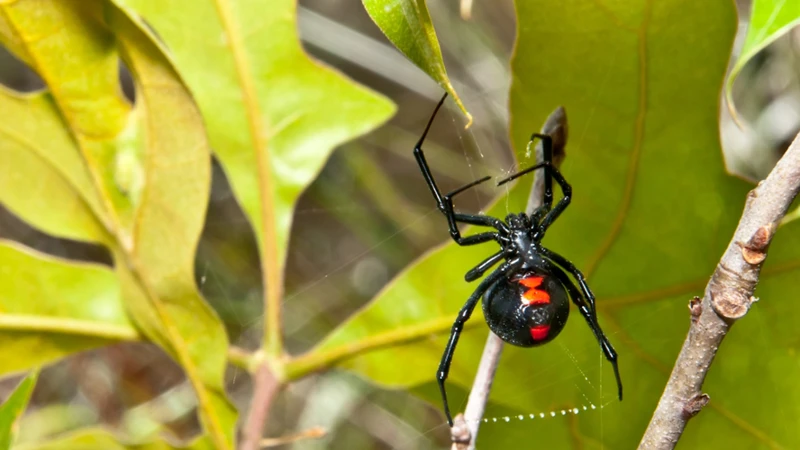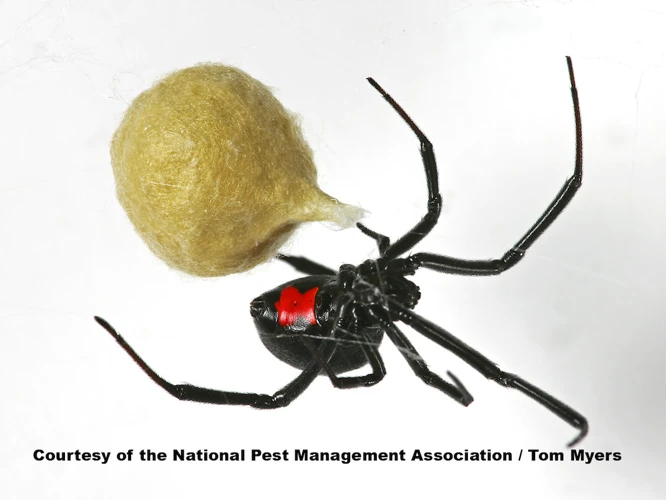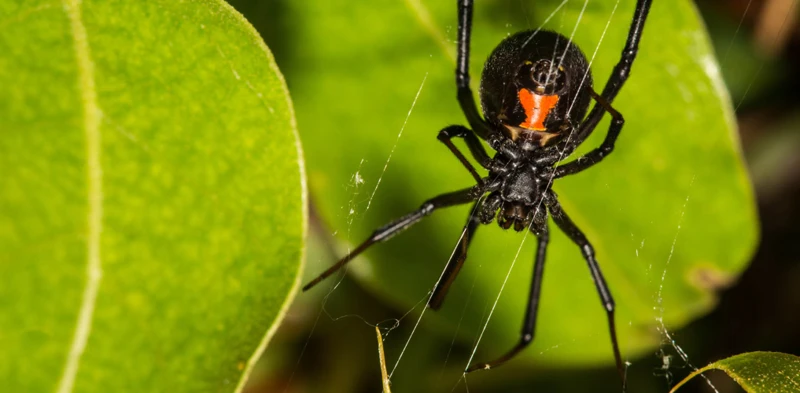As we explore the intricacies of our natural world, it’s essential to examine the role of every species in its ecosystem. In this article, we delve into the mysterious and often misunderstood world of black widow spiders. These sleek and cunning eight-legged creatures have a significant impact on their habitats and play an essential role in maintaining balance in their ecosystems. From their unique characteristics to their feeding habits and their place in the food web, we will uncover the importance of black widow spiders. Get ready to discover the fascinating world of these arachnids!
The Black Widow Spider: Species and Habitat

The Black Widow Spider is one of the most fascinating and terrifying creatures in the animal kingdom. Their iconic red hourglass marking and venomous bite have captured the interest of people all over the world. However, there is much more to these spiders than just their frightening reputation. In this section, we will explore the different species of Black Widow Spiders and where they are typically found, taking into account factors such as climate and environment. For more information on how these factors affect the survival of the Black Widow Spider, check out this article.
Characteristics of Black Widow Spiders
Black Widow spiders are known for their distinctive appearance and venomous bite. These spiders are shiny black in color and have an hourglass-shaped mark on their abdomen, which is neon-red in color. Here are some of the key characteristics of Black Widow Spiders:
- Color: Black Widow spiders are predominantly black in color, with a shiny appearance.
- Size: The adult female Black Widow spider is larger compared to the male, measuring about half an inch in length. Males, on the other hand, are usually smaller and do not pose a threat to humans.
- Venomous Bite: Black Widow spiders have venomous bites, which can be fatal to humans if left untreated. They are considered one of the most venomous spiders in North America.
- Web: Black Widow spiders are known for weaving messy-looking cobwebs, which they use to trap prey.
- Abdomen: As mentioned earlier, Black Widow spiders have a characteristic hourglass-shaped mark on their abdomen, which is the easiest way to identify them.
These features have given Black Widow spiders a unique place in popular culture, leading to a lot of misinformation about their behavior and danger they pose, as well as incorrect identification of other spider species as Black Widows.
Habitat of Black Widow Spiders
The Habitat of Black Widow Spiders varies based on their species and location. Black widow spiders are found in different parts of the world, including North and South America, Australia, and South Africa. They can survive in a range of environments, from deserts to forests, and from sea level to high elevations.
Black widow spiders can thrive in a variety of habitats due to their ability to adapt to different conditions. Some factors that influence their habitat include temperature, humidity, availability of prey, and the presence of natural predators. They can survive in harsh desert climates, where temperatures can reach up to 110 °F. Some species, however, are better suited to cooler and more humid environments.
There are several types of natural environments that black widow spiders are commonly found in. These include dry, rocky areas, forests, and grasslands. They often build their webs in secluded areas, away from human activity. Black widow spiders prefer dark, damp areas such as basements, attics, and woodpiles. They build their webs in areas where their prey is likely to travel, such as along fences, in bushes, or in small crevices.
Black widow spiders have physical features that help them survive in their habitats. They have long legs that enable them to move quickly and navigate through obstacles. They are also able to spin strong webs that can trap prey and protect them from predators.
To sum up, black widow spiders can live in a wide variety of environments due to their ability to adapt to different conditions. They are commonly found in dark and damp areas, such as basements and woodpiles. They build their webs in secluded areas away from human activity, and their physical features help them survive in their habitats. To learn more about how black widow spiders survive in their environments, check out our article on black widow survival.
Food Web and Feeding Habits of Black Widow Spiders

Black Widow Spiders are infamous for their red hourglass marking and venomous bite. However, these spiders also play a significant role in their ecosystems, as their feeding habits and position in the food web are crucial for maintaining balance. Let’s dive deeper into the feeding habits and food web of Black Widow Spiders and explore their contribution to the environment.
Prey of Black Widow Spiders
Black widow spiders are known for their predation skills, and their diet mainly consists of insects, including mosquitoes, grasshoppers, flies, and beetles. The table below highlights some of the black widow spider’s prey:
| Prey | Description |
|---|---|
| Cricket | Small to medium-sized insect with a hard exoskeleton |
| Moth | Flying insect with two pairs of wings |
| Cockroach | Hard-bodied insect with long antennae and six legs |
| Grasshopper | Long-legged insect that hops or flies |
| Beetle | Hard-shelled insect with two sets of wings |
| Cicada | Insect with transparent wings that produces loud buzzing sounds |
Black widow spiders use their webs to capture prey. Their webs are constructed in places where insects are abundant, such as in dark areas like basements, sheds, and garages. Once prey is captured, the spider bites it and injects venom, which immobilizes the prey and starts the digestion process.
Interestingly, some types of black widow spiders found in different environments have evolved to specialize in preying on certain types of insects. For instance, the western black widow spider has been observed feeding on ants, while the northern black widow spider has been found eating woodlice. These behaviors demonstrate the adaptability of black widow spiders in different regions.
It is important to note that black widow spiders also play a critical role in maintaining population control in their habitats. By preying on insects, they help keep populations of potentially harmful pests in check. This can ultimately have a positive impact on the overall ecosystem.
While black widow spiders are effective predators and play an important role in their ecosystems, they are also prey for a number of animals, including birds, lizards, and other spiders. Their survival is dependent on a range of factors, including climate, habitat availability, and physical features. To learn more about what factors impact the black widow spider’s survival, check out our article on Physical Features of Black Widow Spider Survival.
The Importance of Black Widow Spiders in Maintaining Population Control
Black widow spiders play an important role in the ecosystem by maintaining population control. These spiders are known for their predatory behavior, meaning they feed on other insects and animals. By controlling the population of their prey, black widow spiders help to maintain balance in the ecosystem.
The prey of black widow spiders typically consists of insects, such as flies and mosquitoes, as well as other spiders, scorpions, and even small mammals in some cases. Without the presence of black widow spiders to control the population of these animals, their numbers could grow rapidly, potentially causing harm to the environment and other animal populations.
Black widow spiders are also important in preventing the spread of disease by eating insects that can carry illnesses. For example, mosquitoes can carry diseases such as West Nile virus and malaria, which can be deadly to humans. By controlling the population of mosquitoes, black widow spiders can help to reduce the risk of these diseases spreading.
Despite their importance in population control, black widow spiders should still be approached with caution. They are venomous and can be dangerous to humans. However, it is important to note that black widow spiders typically only bite in self-defense and will try to avoid humans.
Black widow spiders are valuable members of their ecosystem due to their role in controlling the population of other animals and insects. By keeping populations in check, they help to maintain balance in the environment and prevent the spread of disease. While they should be treated with caution, black widow spiders are an important part of the natural world.
References:
- https://spiders.asmithgallery.com
- https://www.thespruce.com
- https://www.thoughtco.com
- https://www.nationalgeographic.com
- https://www.pestworld.org
- https://www.liveabout.com
- https://www.terminix.com
The Role of Black Widow Spiders in the Ecosystem
As one of the most well-known spider species, black widow spiders are often feared and vilified. However, these spiders play an integral role in their ecosystems that can often go overlooked. By examining their interactions with both prey and predators, we can gain a better understanding of the unique place these arachnids hold in the natural world. Let’s explore the important role black widow spiders play in their ecosystem.
Black Widow Spiders as Prey for Other Animals
Black widow spiders, despite their reputation as predators, are not immune to becoming prey themselves. In fact, they are considered important prey items for several animals in their ecosystem. Here are some of the animals that prey on black widow spiders:
- Birds: Several species of birds, such as roadrunners, quails, and jays, are known to feed on black widow spiders. Due to the spiders’ venomous nature, birds have developed unique strategies to avoid being bitten. For instance, the roadrunner will pick the spider up by its egg sac and smash it repeatedly against a hard surface until the venom sac is destroyed.
- Scorpions: Scorpions are natural predators of black widows and are immune to their venom. They use their pincers to crush the spider’s body before consuming it.
- Other Spiders: Some spider species, such as the ground spider and the fishing spider, are known to prey on black widows. They use their powerful jaws to subdue the spider before feeding on it.
- Praying Mantises: Praying mantises, with their lightning-fast reflexes, are capable of catching and consuming black widow spiders.
- Small Mammals: Although rare, some small mammals such as shrews, rodents, and even bats have been known to feed on black widow spiders.
Despite the risk of being preyed upon, black widow spiders continue to play an important role in the ecosystem by providing a valuable source of nutrition to many organisms.
Eating Harmful Insects
As predators, black widow spiders play a crucial role in controlling pest populations in their ecosystems. They prey on a variety of insects, including mosquitoes, flies, grasshoppers, and caterpillars. However, their primary food source consists of harmful insects, which makes them essential for maintaining the balance of the ecosystem.
Black widow spiders are known to feed on harmful insects that cause significant damage to crops and other plants. For example, they prey on the cotton bollworm, which is a notorious agricultural pest that feeds on cotton plants, causing significant economic losses to farmers. By feeding on these pests and reducing their population, black widow spiders help protect crops and contribute to sustainable agriculture.
Black widow spiders also feed on disease-carrying insects, such as mosquitoes, which pose a significant threat to human health. Mosquitoes are responsible for transmitting diseases such as malaria, dengue fever, and Zika virus, which affect millions of people worldwide. By feeding on these disease vectors, black widow spiders help control their population, reducing the risk of disease transmission.
To give you a better idea of the types of harmful insects that black widow spiders prey upon, here is a table showcasing some of the most common ones:
| Insect | Harmful Effects | Preyed Upon by Black Widow Spiders |
|---|---|---|
| Plant Lice | Suck the sap from plants, causing damage and deformation | Yes |
| Cotton Bollworm | Feeds on cotton, causing significant economic losses to farmers | Yes |
| Mosquitoes | Carry and transmit diseases such as malaria, dengue, and Zika | Yes |
| Grasshoppers | Feed on crops and other plants, causing defoliation and damage | Yes |
| Flies | Carry and transmit diseases such as typhoid, cholera, and dysentery | Yes |
| Caterpillars | Feed on leaves and fruits of plants, causing significant damage to crops | Yes |
Black widow spiders play a significant role in controlling harmful insect populations in their ecosystems. By feeding on pests that can cause significant damage to crops and spread diseases, black widow spiders help maintain the balance of the ecosystem and contribute to sustainable agriculture and human health.
Contribution to the Biodiversity of the Habitat
Black Widow spiders play a crucial role in maintaining the biodiversity of their habitats. They are a part of the intricate food web, where each species contributes to the balance of the ecosystem. Here are some specific ways in which Black Widow spiders contribute to the biodiversity of their habitat,
1. Controlling population of prey species: By feeding on a variety of insects, including mosquitoes, flies, and moths, Black Widow spiders help in controlling their populations. This, in turn, helps in maintaining a balance in the food web and prevents the overgrowth of certain insect species.
2. Providing food for other animals: Black Widow spiders are a source of food for a wide range of animals, including birds, reptiles, and mammals. The presence of Black Widow spiders in the ecosystem provides an additional food source for these animals, thereby increasing their chances of survival.
3. Acting as pollinators: Black Widow spiders are known to feed on nectar from flowers, and in doing so, they inadvertently transfer pollen from one flower to another. This makes them important pollinators in certain ecosystems.
4. Supporting the habitat’s food chain: Black Widow spiders occupy a crucial place in the food chain of their habitat. As predators, they feed on a variety of insects, which in turn are eaten by larger predators. Black Widow spiders are an essential link in this chain, and their presence helps in maintaining the balance of the ecosystem.
Black Widow spiders are vital to their habitats and contribute to the biodiversity of their ecosystems in multiple ways. Their importance highlights the need for conservation efforts to preserve their populations and ensure the health of their habitats.
Conclusion
In conclusion, black widow spiders play a critical role in their ecosystems. They are fascinating creatures with unique characteristics that enable them to survive and thrive in a variety of habitats. Despite their notoriety for being venomous, black widows are an essential part of the food web and help to maintain population control.
Through their predatory behavior, black widow spiders help to keep populations of insects and other arthropods in check. They also provide a valuable food source for many other animals, including birds, reptiles, and mammals. The consumption of harmful insects also contributes to the overall health and biodiversity of their habitat.
It is important to note, however, that black widow spiders can be dangerous to humans, and caution should always be exercised when in their presence. Educating oneself on their behavior and avoiding unnecessary contact with them is key to avoiding potential harm.
Despite the risks, black widow spiders are fascinating creatures that have an important role to play in our ecosystems. By understanding their behavior and the vital role they play, we can appreciate and respect these remarkable creatures and the role they play in our world.
Frequently Asked Questions
What is the venom of a black widow spider like?
The venom of a black widow spider is a neurotoxin that targets the nervous system of its prey. It can cause symptoms such as muscle spasms, cramps, and sometimes even death in humans.
How do black widow spiders catch their prey?
Black widow spiders use webs to catch their prey, which can include insects, other spiders, and even small animals.
Are all black widow spiders black in color?
No, not all black widow spiders are entirely black in color. Females can have red or orange markings on their thorax and abdomen, while males usually have yellow or white markings.
Can black widow spiders be kept as pets?
While some people do keep black widow spiders as pets, it is not recommended due to their venomous nature and potential danger to humans.
How long can black widow spiders live for?
Black widow spiders can live for up to three years in the wild.
What should I do if I am bitten by a black widow spider?
If you are bitten by a black widow spider, seek medical attention immediately. It is important to remember that the symptoms can be severe and potentially life-threatening.
Do black widow spiders have any predators?
Yes, black widow spiders have several predators, including birds, lizards, and small mammals such as shrews and rodents.
What is the mating behavior of black widow spiders?
During mating, the female black widow spider will sometimes eat the male spider. This behavior, known as sexual cannibalism, is believed to increase the female’s chances of survival and successful reproduction.
Where are black widow spiders typically found?
Black widow spiders are typically found throughout North and South America, in areas such as deserts, forests, and even urban areas.
Are black widow spiders endangered?
Black widow spiders are not currently listed as endangered, although habitat loss and pesticide use can threaten their populations.






